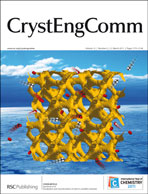Small chemical causes drastic structural effects: the case of calcium glutarate†
Abstract
A microporous calcium dicarboxylate material, denoted as BioMIL-2 (BioMIL stands for Bioactive Materials from Institut Lavoisier) has been obtained under solvothermal conditions. The material, composed of calcium, a non-toxic and therapeutic element, and the experimental ![[3 with combining macron]](https://www.rsc.org/images/entities/char_0033_0304.gif) ), within which helical chains of edge-sharing 7 coordinate calcium polyhedra are linked together in order to form a 3-dimensional network with a 1-dimensional pore system. The pores are inaccessible to N2 as they are lined with the carbon atoms of the glutaric acid moiety. Upon hydration, the calcium helicals are separated, yielding a 3-dimensional, non-porous, chained known structure. The hydrated material, BioMIL-2-hyd (CaO4OH2C5H6), crystallises in an orthorhombic setting (a = 6.78(1)Å, b = 18.42(1)Å, c = 5.87(1)Å, V = 733.04(2)Å3 space group: P212121) with the structure built up from seven-coordinate dual-capped bipentagonal calcium polyhedra arranged into chains which are connected to each other viaglutarate anions creating a 3-dimensional hybrid structure. The thermal behaviour of BioMIL-2 has been investigated using
), within which helical chains of edge-sharing 7 coordinate calcium polyhedra are linked together in order to form a 3-dimensional network with a 1-dimensional pore system. The pores are inaccessible to N2 as they are lined with the carbon atoms of the glutaric acid moiety. Upon hydration, the calcium helicals are separated, yielding a 3-dimensional, non-porous, chained known structure. The hydrated material, BioMIL-2-hyd (CaO4OH2C5H6), crystallises in an orthorhombic setting (a = 6.78(1)Å, b = 18.42(1)Å, c = 5.87(1)Å, V = 733.04(2)Å3 space group: P212121) with the structure built up from seven-coordinate dual-capped bipentagonal calcium polyhedra arranged into chains which are connected to each other viaglutarate anions creating a 3-dimensional hybrid structure. The thermal behaviour of BioMIL-2 has been investigated using


 Please wait while we load your content...
Please wait while we load your content...